Elevate Your Laundry Room with Stylish Wall Units
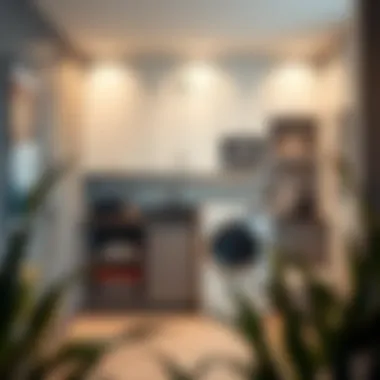
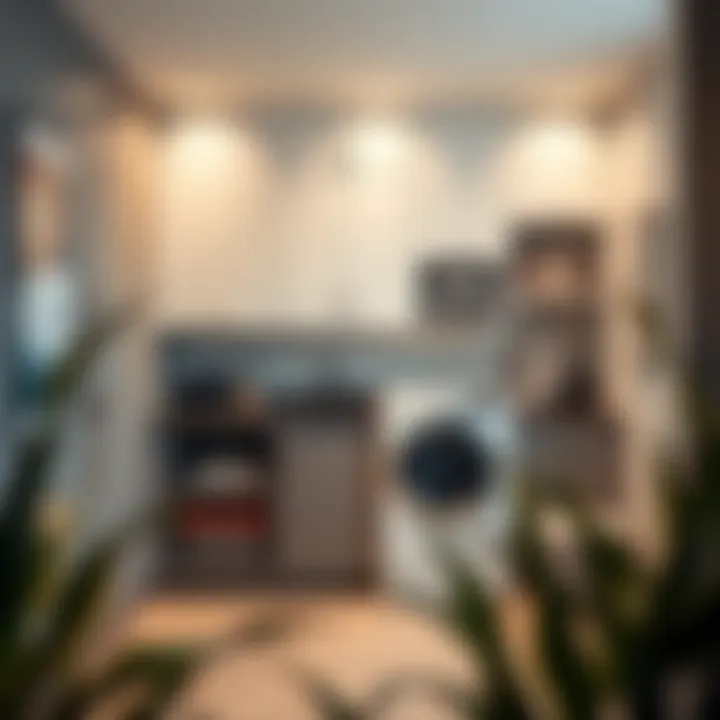
Intro
In today’s fast-paced world, the function of our spaces often takes center stage, especially in areas like the laundry room. Far from the mundane task it once was, this space has become a crucial component of our homes, deserving careful planning and thoughtful design. Laundry room wall units, often overlooked, play a pivotal role in maximizing utility and enhancing the visual appeal of this practical area.
By integrating these wall-mounted solutions, homeowners can unlock vast potential, transforming their laundry spaces from mere necessities into functional hubs of style and efficiency. This guide seeks to explore the intricate world of laundry room wall units, examining their design aspects, materials, and the latest trends that can help elevate any laundry room experience.
From sleek cabinetry that blends in seamlessly with other decor to custom shelving that caters specifically to individual needs, wall units are versatile tools that can easily adapt to various styles and requirements. Let’s delve into the latest trends in furniture design and discover how wall units can transform your laundry room into a space that’s as efficient as it is attractive.
Intro to Laundry Room Wall Units
In today’s world, where space is often at a premium, particularly in urban settings, every square inch of a home counts. The laundry room, frequently a neglected part of the house, is evolving into a multifunctional space that deserves thoughtful design and efficient storage solutions. Laundry room wall units are more than just shelves or cabinets; they represent a strategic approach to maximizing utility while enhancing the overall aesthetic of the room.
Wall units allow for a seamless integration of form and function. They can turn an ordinary laundry area into a highly efficient workspace, combining the need for storage with the desire for style. These units become central to the organization, making it easier to manage laundry tasks and keep necessary supplies at hand without cluttering surfaces. In essence, they elevate the laundry experience from mundane chores to a streamlined process.
When considering the installation of wall units, several key factors come to light:
- Space Optimization: Wall units utilize vertical space, reducing the footprint on the ground and providing more room for other crucial tasks in a laundry area.
- Design Flexibility: Available in myriad styles, from sleek contemporary designs to rustic wooden cabinets, these units can match any interior theme, adding character and charm.
- Improved Workflow: With items organized and within easy reach, the convenience of finding what you need—be it detergent, fabric softener, or laundry baskets—improves efficiency during laundry days.
Moreover, as homeowners are increasingly seeking to personalize their spaces, laundry room wall units offer a level of customization that meets individual needs. Adjustable shelving, various finishes, and personal hardware choices make it easy to tailor these units to specific requirements, preventing a one-size-fits-all approach to storage.
"The laundry room may dwell at the back of the house, but it doesn't have to settle for a lackluster design. A wall unit can transform not just the room's function but its character too."
The Practical Benefits of Wall Units in Laundry Rooms
When it comes to laundry rooms, wall units are like the Swiss Army knives you didn’t know you needed. They’re practical, versatile, and can really up the ante if you’re aiming for a more organized space. It’s not just about aesthetics; it’s about function, and that’s what makes these units so valuable.
Maximizing Space Utilization
In a room where square footage can feel painfully scarce, wall units come to the rescue. They allow for vertical storage, which means you can utilize every inch of wall space without cramming your essentials into the corners. Think about it: instead of letting that wall gather dust, you can turn it into a storage haven. By going vertical, you free up floor space which can be a game changer in tight areas.
- Create zones: Designate specific sections for cleaning supplies, laundry essentials, or even a folding area. This separation keeps things tidy and helps avoid that dreaded clutter explosion.
- Corner units: Consider adding corner shelves or wall units to transform those pesky, underutilized areas into functional storage.
"A well-organized space not only looks good; it also saves time while doing your chores!"
Organizational Advantages
Clutter can spiral out of control faster than a washing machine on spin cycle. Wall units provide a solid answer to keeping your laundry room in shipshape. With dedicated spots for your items, it becomes easier to locate what you need without rummaging through piles of products.
- Clear labeling: Open shelving makes it easy to see items at a glance, so you don’t end up buying duplicates of fabric softener just because you forgot what was stashed away.
- Baskets and bins: Add baskets or decorative bins, and suddenly that chaos transforms into a curated display, looking intentional instead of haphazard.
Enhanced Functionality
Let’s not overlook the enhanced function these units can offer. A well-planned wall unit can incorporate features like fold-out ironing boards, drying racks, or even built-in hampers. This integration of features means you can do more in the same space — no more juggling laundry baskets and piles as you shuffle about.
- Custom compartments: Tailor units to include sections specific to your needs, whether that’s a spot for dog towels or space for a dual washer and dryer setup.
- Smart design elements: Consider under-cabinet lighting. It can illuminate your workspace, making late-night laundry sessions less of an ordeal.
Design Options for Laundry Room Wall Units
In the realm of laundry room design, wall units have become a pivotal element, transcending mere functionality to embody style and efficiency. The options available in design not only cater to personal taste but are tailored to optimize utility in often overlooked spaces. Selecting the right design choice can transform a mundane laundry area into a well-organized, aesthetically pleasing part of the home.
Open Shelving
Open shelving is a popular design choice for many homeowners seeking to combine accessibility with visual appeal. This design allows for the display of decorative baskets, neatly folded towels, and even stylish detergent bottles. The allure of open shelving lies in its ability to create a sense of airiness and openness in a space that often feels cramped.
- Advantages: Open shelves encourage visible organization and prompt you to keep items tidy. It's also easier to grab items quickly without rummaging through cabinets.
- Considerations: Dust accumulation can be an issue, so regular cleaning becomes essential. Plus, while visually attractive, you'll need to be selective about what you display to avoid a cluttered appearance.
With an endless variety of materials and styles, open shelves can also tailor to various design aesthetics— from rustic wood to sleek metal finishes, offering a myriad of possibilities that suit different preferences.
Closed Cabinets
In contrast, closed cabinets provide a more subdued and refined look—offering privacy and cleanliness. These units serve as a solid barrier against dust and clutter, perfect for storing less visually appealing items. They can be installed at various heights, providing smart storage solutions that can conceal tall bottles or messy laundry supplies.
- Benefits: Cabinets can create a more streamlined look. This design works best for those who prefer a fuss-free appearance. Additionally, they can double as a surface for folding clothes or even serve as a decorative statement with the right hardware.
- Considerations: When opting for closed cabinets, think about accessibility. Deep drawers, or high cabinets may hinder easy access to stored goods. Ensuring the cabinet heights work well with your workflow is crucial for maintaining efficiency.
Combination Units
Combination units blend the best of both worlds by incorporating both open and closed storage. These hybrid solutions appeal to versatility and organization, allowing homeowners to showcase decorative items while still providing ample concealed storage for less-than-stylish supplies.
- Perks: The versatility makes combination units a favorite among those who are passionate about design yet require practicality. You can utilize the top half for feature items—like plants or framed photos—while relegating all the heavy-duty supplies behind closed doors.
- Points to Ponder: Layout is important when choosing combination units. If the layout isn't carefully planned, you could end up with space that feels choppy rather than cohesive. It's essential to ensure visual continuity and practical flow within the design.
"A well-designed laundry room can seamlessly blend functionality and aesthetics, proving that even mundane chores can take place in a beautiful setting."
In essence, each of these design options serves a unique purpose, increasing not just the visual appeal but also the pragmatic usability of the laundry room. Whether you’re inclined towards the open, airy feel of open shelving, the organized simplicity of closed cabinets, or the hybrid ingenuity of combination units, the right choice can revolutionize your laundry experience.
Materials Used in Laundry Room Units
When it comes to outfitting your laundry room with wall units, the choice of materials plays a pivotal role. Not only do the materials influence the look and feel of the space, but they also contribute to the overall functionality and durability of the units. With various options on the market, selecting the right material can enhance organization, ease of maintenance, and longevity, while also reflecting personal style.
Wood Options
Wood is a timeless classic that brings warmth and character to any laundry room. Whether it’s oak, maple, or birch, the natural grains and textures can create a cozy environment. Solid wood offers strength and stability, ensuring that your shelves can handle the weight of detergent bottles, fabric softeners, and other essentials.
"Wood can be both rustic and sophisticated, making it flexible for various designs."
However, there are considerations to keep in mind. Moisture can be a problem in laundry rooms, so it’s essential to treat wood with proper finishes that provide a layer of protection from humidity. Raw wood isn’t ideal when it comes to spills or water exposure. Homeowners might consider sealed or stained options that can repel water effectively, without compromising aesthetics.
Metal and Glass Combinations
The juxtaposition of metal and glass is becoming increasingly popular in modern laundry room designs. Metal frames, especially in stainless steel or matte finishes, provide a sleek and industrial touch that can stand up to the rigors of daily use. Glass shelves or cabinet doors pair beautifully with metal by adding an element of transparency, creating an open feel in the space.
This combination is not just about style; it also allows for easy visibility of items. You can quickly locate cleaning supplies and laundry tools without rummaging through shelves. Moreover, metal is inherently resistant to moisture and can be easily wiped clean, while glass can be treated for added durability.
Individuals looking to install these units should ensure that the metal used is rust-resistant, particularly in humid environments, to maintain the integrity of the design over time.
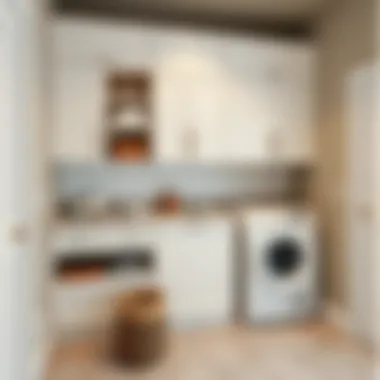
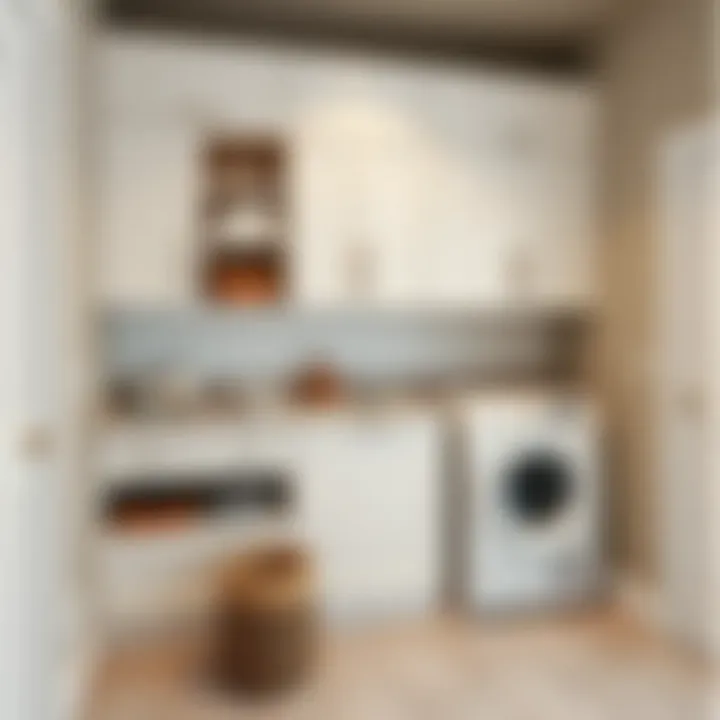
Composite Materials
Composite materials are material blends designed to offer the best of both worlds. Usually crafted from a combination of wood fibers and synthetic resins, composites provide an excellent balance of durability and aesthetics. They can be engineered to mimic the appearance of solid wood while resisting warping, cracking, and moisture damage, making them a great option for laundry rooms.
In addition, composites are often more lightweight than solid wood, which can ease installation and reduce stress on wall structures. This can be particularly beneficial for those updating older homes or retrofitting into smaller spaces. A variety of finishes are available, allowing homeowners to seamlessly integrate them with existing decor.
With the right choice of materials, homeowners and designers can create wall units that not only serve practical needs but also enhance the overall design and feel of the laundry room. As you consider your options, remember each material's specific qualities will inform the decision based on your individual aesthetic and functional requirements.
Current Trends in Laundry Room Design
The world of laundry room design is shifting, shaped by lifestyle changes, environmental awareness, and the burgeoning rise of smart technology. These trends reflect a move towards not just functionality, but also aesthetics and sustainability. Designers and homeowners alike are realizing that the laundry space can be both practical and visually appealing. Understanding these trends is crucial for anyone looking to revamp their laundry space.
Sustainability in Materials
Sustainability has become more than just a buzzword; it’s now a pivotal aspect of design. Homeowners are increasingly seeking laundry room wall units made from eco-friendly materials. Bamboo, reclaimed wood, and even recycled metals are making their mark.
By opting for sustainable materials, you contribute to reducing carbon footprints while also enjoying durability and unique aesthetics. For instance, bamboo not only grows quickly but is also resistant to aging and damage, making it an ideal choice for cabinetry in a laundry setting. The push toward sustainable materials fosters a healthier home environment.
"Using sustainable materials is a win-win: you get a stunning design while supporting the planet."
Minimalist Aesthetics
The minimalist trend has infiltrated laundry rooms as part of a broader design movement that values simplicity and functionality. Homeowners are leaning toward clean lines, neutral palettes, and uncluttered spaces. This approach minimizes distractions, allowing for a calming atmosphere in what can often be a hectic household chore environment.
A minimalist aesthetic in laundry room design often features:
- Streamlined cabinets with flat panel doors that hide clutter away.
- Neutral shades, such as whites, beiges, or soft grays, that create an airy feel.
- Innovative storage solutions that are both clever and unobtrusive.
By embracing this style, homeowners can create a space that not only serves its intended purpose but also contributes to a serene home environment.
Smart Technology Integration
Another rising trend is the integration of smart technology into laundry rooms. This includes appliances that communicate with each other, allowing for a more seamless experience. For example, smart washers and dryers can send notifications to your smartphone, letting you know when a cycle is done—no more question marks about how long to wait!
Moreover, smart home systems can manage energy consumption more efficiently, leading to significant utility savings. Homeowners might use sensors that adjust the drying time based on moisture levels or utilize smart faucets that provide optimal water usage. These tech innovations not only enhance convenience but also improve the overall efficiency of laundry tasks.
In summary, the current trends in laundry room design emphasize a combination of sustainability, minimalism, and smart technology. Embracing these elements can transform an ordinary laundry area into a stylish, functional, and environmentally friendly space.
Color Schemes and Finishes
Color schemes and finishes play a critical role in the overall design and feel of laundry room wall units. They influence not just the aesthetics but also the emotional response one gets when stepping into the space. If you think about it, the color of the walls, cabinetry, and even the textures can create an atmosphere that makes chores less of a grind. It's worth noting that a well-thought-out color strategy not only beautifies but also can enhance functionality. Dark finishes, for example, might hide stains better than light tones, while bright colors can uplift an otherwise dull chore.
The choices in color and finish should depend on various factors. For starters, you might want to consider the amount of natural light in your laundry space. Furthermore, the other elements within the room, such as flooring and laundry appliances, can affect your choices. This section will delve deeper into specific themes surrounding neutral tones, vibrant colors, and textured finishes to illustrate how these elements can come together harmoniously.
Neutral Tones and Their Appeal
Neutral tones have an undeniable charm because of their versatility. Think about it – shades like beiges, grays, and whites act as the perfect backdrop for other design elements. They can make a small room feel more expansive or create a calm environment with their understated flair.
These colors can blend seamlessly with various materials, be it wood, metal, or glass, allowing for versatility in decor. Plus, they are easier to maintain seeing as they don’t show wear as easily as brighter shades. An added bonus? Neutral tones can match with almost any style, from farmhouse chic to modern minimalism, providing a blank canvas for you to express your personal taste.
Bold Colors and Statement Pieces
If your laundry room is the kind of place needing a jolt of creativity, bold colors might just be the answer. Vibrant shades like deep blues or sunny yellows can add a splash of personality and energy to the space. These hues can also act as a focal point, drawing the eye and sparking joy every time you complete a laundry load.
Highly saturated colors can work best when used selectively, perhaps on an accent wall or a particular shelf. You might consider statement pieces, such as custom knobs or a colorful backsplash, that harmonize with the bold color choice. If someone asks you how you feel about doing laundry, you can confidently say, 'I love it!', thanks to the energizing environment you created!
Textured Finishes for Added Interest
Textural diversity never goes out of style and can elevate a simple laundry room significantly. Imagine reaching for detergent in a unit that has a textured finish – it’s tactile and visually intriguing. Textured finishes can include anything from a rough-hewn wood to a smooth metal, each imparting its impression on the space.
Textures can also help to mask imperfections from daily wear and tear, making them both a practical and aesthetic choice. Keep in mind that mixing textures can create a layered effect, adding complexity to your design. For instance, pairing a rustic wood finish with smooth metal or glass can create a dialogue of contrasts, making your laundry area not just functional but also stylish.
"The right colors and finishes can transform a mundane chore into an experience of joy and creativity."
In sum, the color schemes and finishes you choose for your laundry room wall units assert not just personal style but can also have lasting impacts on mood and functionality. Whether you prefer the calming nature of neutrals, the energy of bold colors, or the dynamism of textured finishes, this is where design can intersect beautifully with practicality.
Recommended Resources:
Consider these aspects of color and finish as solid building blocks when planning your own laundry room design.
Customizable Options for Wall Units
When it comes to laundry room wall units, the word "customizable" is more than just a trend—it's a necessity. A laundry room is often a hub of chores and organization, making it essential to optimize every inch. Customizable options allow homeowners to tailor their spaces specifically to their needs, preferences, and the unique constraints of their rooms. From tailored sizes to adjustable shelving, the ability to modify these units offers significant benefits that can enhance both functionality and style.
Tailored Sizes and Configurations
One of the standout aspects of customizable wall units is the option for tailored sizes and configurations. Not every laundry room has the luxury of abundant space; some are mere alcoves, while others might have quirky layouts due to architectural idiosyncrasies. By opting for custom sizes, homeowners can create wall units that perfectly fit the available area.
- Maximized Space: Customized units generate more storage by utilizing the room's dimensions efficiently. Imagine a corner wall unit hugging the walls—an otherwise wasted space morphs into a storage haven.
- Personalized Layouts: Tailored configurations allow for additional features like built-in hampers or pull-out baskets. This adaptability equips users to design their workflow around their habits, making laundry day less of a chore.
Adjustable Shelving Solutions
Another remarkable feature of customizable laundry units is adjustable shelving. Not only do adjustable shelves offer flexibility in height and space utilization, they also make it easy to modify according to changing storage needs. As your laundry habits evolve, so can your wall unit.
- Dynamic Storage: For instance, if you buy larger detergent bottles or add more fabric softener varieties, adjustable shelves enable you to expand your storage space without having to resort to external solutions.
- Organizational Benefits: Aligning shelves based on frequency of use keeps your essentials close without any hassle. By being able to shift a shelf up or down, you find a balance between functionality and organization.
Personalized Hardware Selections
Custom wall units offer a facet often overlooked—personalized hardware selections. The small details within a unit inadvertently plays a big role in the overall aesthetic and functionality. From knobs to handles, the options are limitless.
- Aesthetic Cohesion: Choosing hardware that aligns with your interior style can transform a laundry unit from merely functional to a statement piece. Whether it’s sleek modern handles or rustic knobs, there’s something available for every design flavor.
- End-User Usability: Consider the practicality of hardware as well. Some designs ensure easy grip and accessibility, while others boast built-in soft-close mechanisms, ensuring smooth operation and enhanced safety.
Customizable wall units represent a commitment to merging necessity with style; they transform the mundane task of doing laundry into a streamlined, elegant experience.
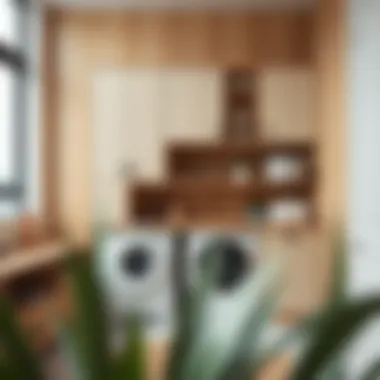
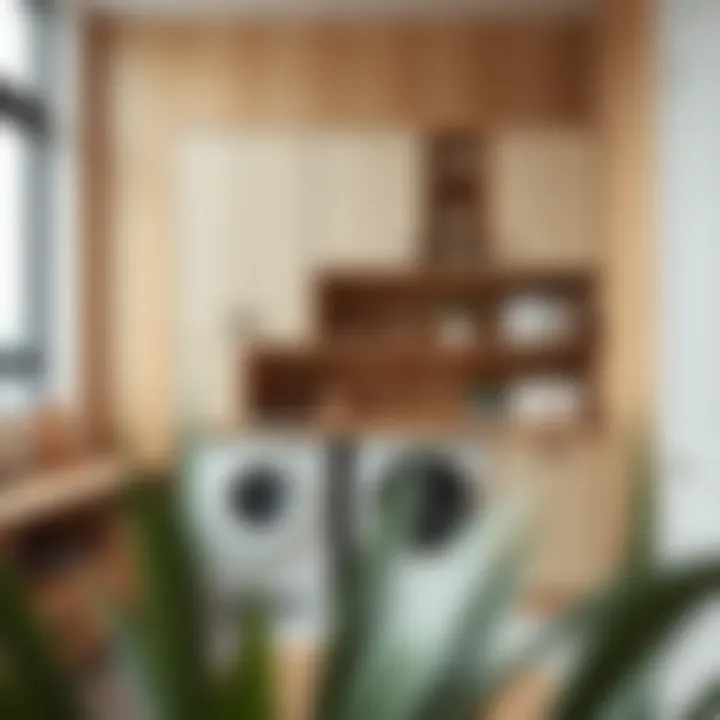
Integrating Laundry Units into Existing Spaces
Integrating laundry units into existing spaces is not just about placing a few shelves and cabinets; it's about crafting a well-thought-out environment that addresses both aesthetic appeal and practical functionality. Laundry rooms often serve multiple purposes, from storage to utility, but when integrated seamlessly into the layout of a home, they can elevate both design and daily operational efficiency. Here are essential elements to consider when tackling this integration:
Spatial Considerations
Before diving into design, it's crucial to assess the spatial dimensions of your laundry area. The amount of space on hand will dictate what can realistically fit. Measuring every inch is key. Take the time to measure not just the wall space available, but also the height from the floor to the ceiling. This measurement can help determine if stacks of closed cabinets or open shelves would work better. Additionally, consider the room’s actual configuration—some layouts lend themselves to corner units, while others might benefit from a sleek linear design.
- Use vertical space: When floor area is limited, tall shelves can create additional storage without crowding the area.
- Flow of movement: Ensure that there’s sufficient space for doors to open and people to move around without bumping into units.
- Functional zones: Divide the laundry room into work zones, such as washing, folding, and storage to optimize workflow.
Flow and Accessibility
Creating a smooth workflow in your laundry room is a game changer. A well-planned layout should facilitate an effortless transition between tasks—this is where flow and accessibility come into sharp focus. Think about how you move through the space, and align the units accordingly.
- Easier access to detergent and tools: When designing units, keep commonly used items within reach—maybe a lower shelf for detergents and a hanging area for drying clothes right above.
- Pedestrian traffic patterns: Design the layout to promote easy movement. A path from the washer to the dryer, and then to folding areas, should be as straightforward as pie.
- Family accessibility: If kids are lending a hand or if the laundry doubles as a mudroom, consider adjustable shelving that grows with the household's needs.
Coordinating with Existing écor
Your laundry room doesn't have to feel like a utility closet. It can, and should, mirror the aesthetic of the surrounding spaces for a cohesive look. Achieving this harmony involves thoughtful selection of materials, colors, and finishes. Here’s how to get started:
- Match materials and colors: If your house leans towards a rustic vibe, a wooden wall unit might work better than a sleek metal one.
- Stylistic alignment: Look at the details in other rooms. If the bathroom has accents in bronze fixture, consider incorporating similar soft metallic notes to the laundry space.
- Decorative touches: Use light fixtures or wall art that align with the broader design narrative of your home, making your laundry room a place that feels just as loved as the rest of the house.
As you can see, integrating laundry units into existing spaces is not just about utility; it's about enhancing the user experience, ensuring flow, and crafting a cohesive environment. Understanding these elements will greatly inform and improve the decision-making process as you strive to create a functional and stylish laundry room.
DIY Options for Laundry Room Wall Units
When it comes to laundry room wall units, the DIY route opens the door to a world of possibilities. Not only can you tailor the project to suit your specific needs and preferences, but you also get the satisfaction of crafting something unique. Working on this kind of project can save you money and allow you to express your style without splurging on overpriced pre-made options. Let’s look closer at some fundamentals that can make your DIY endeavor a success.
Planning Your Project
Before grabbing any tools, it's crucial to map out your plans. Start by evaluating the space available in your laundry room. Measure the wall where you want to install your wall unit—don’t forget to account for any obstacles like plumbing, electrical outlets, or windows. It’s wise to sketch a design on paper or use software for a visual idea.
Consider how the unit will serve you—will it hold detergents and cleaning supplies? Or maybe you're after a sleek storage option for laundry baskets? This needs assessment helps inform not only the design but also the materials you’ll ultimately choose.
Essential Tools and Materials
Gathering the right tools and materials is a significant step in your DIY project. Here’s a list to steer you in the right direction:
- Tools:
- Materials:
- Drill
- Screwdriver
- Level
- Tape measure
- Saw (hand or power)
- Sandpaper or a sander
- Plywood or solid wood for shelves
- Brackets for support
- Screws and anchors
- Paint or stain for finishing touches
- Optional: decorative hardware like knobs or handles
This collection might shift a bit based on your specific design, but it's a solid starting point.
Execution and Assembly Tips
With your plan in place and tools and materials at the ready, it’s time to dive into execution. Here are a few tips to make this go as smooth as butter:
- Start with the Frame: Use your measurements to cut the wood accurately. Assemble the frame using screws, ensuring everything is square and even. A level is your best friend here.
- Support Your Shelves: If you’re adding shelves, make sure they have adequate support. Use brackets at the corners and in the center to prevent sagging, especially if you plan to store heavy items.
- Finishing Touches: Sand down rough edges for a polished appearance. If you’re painting or staining, do this before mounting the unit to keep things clean. Allow proper drying time and consider applying more than one coat for a deeper color.
- Mounting: When it comes to installation, it's best to anchor to the wall studs. This ensures your unit is securely attached, minimizing the risk of tipping or falling.
Building your own laundry room wall unit may seem daunting at first, but taking it step-by-step can simplify the process. Not only will you create a tailored space, but you'll also gain valuable skills along the way. DIY isn’t just about saving money; it’s about creating a space that feels truly yours.
Maintenance and Care for Laundry Units
Keeping laundry room wall units in good condition is key to prolonging their life and utility. Just like any piece of furniture in your home, these units require regular care. The right maintenance can prevent both minor and major issues, which translates into saving time and possibly money over time. A few simple practices can extend the lifespan of these units while using them efficiently.
Routine Cleaning Practices
Regular cleaning of your laundry wall units is crucial for maintaining their appearance and functionality. Dust, lint, and various residue can accumulate over time, affecting both aesthetics and performance. Start with this simple routine:
- Wipe Down Surfaces: Use a soft, damp cloth to remove dust and debris from the surfaces. If stubborn stains appear, a mild soap and water solution can work wonders.
- Clear Out Clutter: Periodically, take the time to declutter shelves. Items tend to pile up, and a fresh start can provide an organized look while making it easier to find things when you need them.
- Check for Moisture: Since laundry areas can be humid, check for signs of mold or mildew. A quick inspection every month can save you from more significant cleaning later.
Managing Wear and Tear
Everyday use can lead to wear and tear, especially if the laundry room is a high-traffic area. Here are some aspects to consider:
- Identify High-Use Areas: Pay attention to the spots that tend to get used most, whether it’s where you store detergent or the used shelf space. These areas may need more frequent inspections.
- Avoid Overloading: It’s tempting to stuff units full, but overloading can damage shelves or even cause them to sag. Be mindful of weight limits to avoid unnecessary strain.
- Use Coasters or Mats: If you place heavy items on surfaces, using coasters can prevent scratches and dents.
Repairing Damages
Inevitably, damages may occur despite your best efforts. Knowing how to address them can turn a potential headache into a minor bump in the road. Here’s how:
- Assess the Damage: Take a close look at any cracks or dents. Some may be superficial, while others could indicate deeper issues that need urgent attention.
- Quick Fixes: For small scratches, a wood touch-up pen or paint can be an easy solution. If something is chipped or broken, sometimes a glue like E6000 can provide a durable fix for wooden units.
- Replace Hardware if Needed: Loose knobs or rusted handles can detract from your unit's functionality. Replacing these is straightforward and can refresh the whole look of your laundry room.
"Maintaining your laundry units not only preserves their functional value but also enhances your home's aesthetic appeal."
Engaging in these maintenance and care practices helps keep your laundry area looking its best. Regular upkeep can ensure that your wall units support organization and function, enhancing the overall laundry experience.
The Cost of Laundry Room Wall Units
When it comes to laundry room wall units, understanding the cost nuances is just as crucial as knowing the design or functionality aspects. Wall units often represent a significant investment in both time and money for homeowners. Knowing the price range can help you plan better and make informed decisions. It’s not just about picking a style that pleases the eyes; you also need to align it with your budget while ensuring that the investment pays off in terms of functionality and efficiency.
Budgeting for Your Project
Creating a budget for your wall unit project is the first step in keeping your finances in check. Picture the costs like a puzzle you need to piece together: you’ll have multiple elements to consider. The price can vary widely based on materials, complexity of design, and installation costs.
- Material Selection: Wood tends to be pricier than composite materials, but it offers durability and aesthetic appeal. Metal units may offer a sleek look but can be more expensive based on the finish.
- Design Complexity: Custom designs will inevitably cost more than pre-fabricated units. Yet, they allow you to tailor the space to your specific needs.
- Installation Fees: If you're not keen on a DIY approach, hiring professionals can add to the total cost significantly.
Plan for some room to wiggle; it’s prudent to have a buffer of 10-15% to cater for unexpected costs or upgrades.
Comparative Costs of Materials
Embarking on a comparison journey of materials can save you some bucks in the long haul. Every material comes with its own price tag. Here’s a glance:
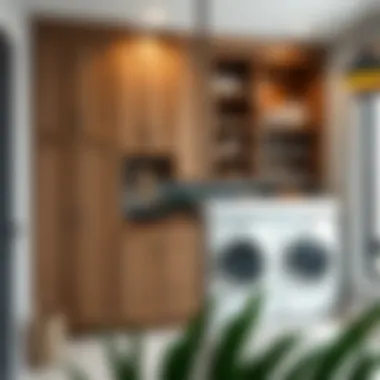
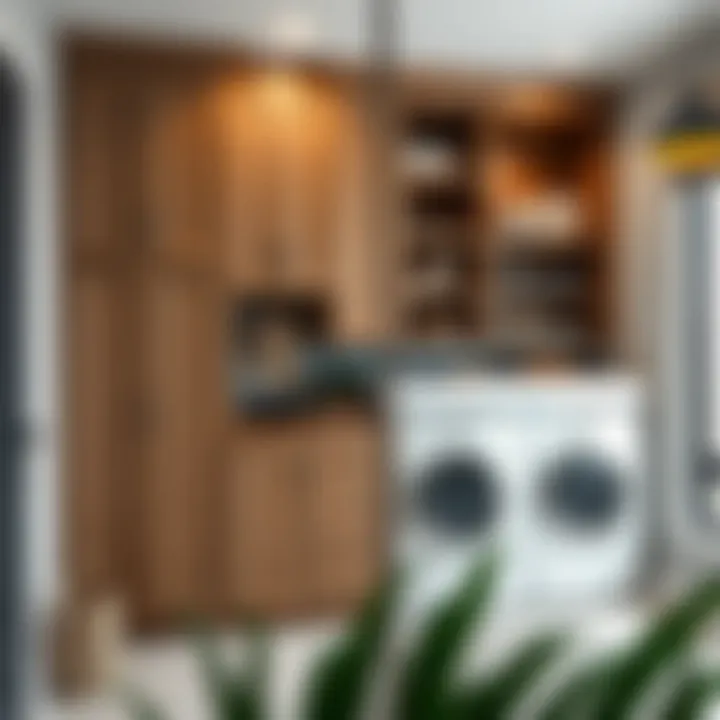
- Solid Wood: This is often viewed as the gold standard. Expect to shell out anywhere from $100 to $300 per linear foot.
- Plywood and MDF: More budget-conscious choices, averaging from $50 to $150 per linear foot. They can still provide decent aesthetics when painted or finished well.
- Metal Options: When you think sleek and modern, metal might come to mind. Depending on the type, pricing can range dramatically, usually falling between $75 to $250 per linear foot.
By weighing these costs, homeowners can strike a balance between aesthetics, durability, and budget.
Investing for Long-Term Benefits
The initial expenditure on wall units might give you pause, but let’s not forget the long-term benefits here. Think of your laundry room as an investment in home utility. A well-designed, functional unit can elevate the value of your home significantly.
Consider this:
- Increased Home Value: Well-planned units often enhance overall market value, making your home more appealing to future buyers.
- Longer Lifespan: Investing in high-quality materials today can save you repair or replacement costs down the line, giving you peace of mind.
- Enhanced Efficiency: Efficiently organized spaces streamline the laundry process. A tidy area reduces time spent looking for necessary items and promotes a more enjoyable chore.
Ultimately, a smart investment today could very well stand the test of time, providing rewards that stretch beyond mere aesthetics.
Investing in quality materials and thoughtful design isn't just about laundry—it's about lifestyle upgrades that make everyday tasks more enjoyable.
For homeowners keen to amplify their laundry experience, delving into cost considerations can shape the overall effectiveness of their space. The value you receive from these wall units goes beyond simple utility; it encapsulates ease, style, and enticing potential for future transformation.
Case Studies of Successful Wall Unit Installations
In the realm of home design, case studies serve as a treasure trove of inspiration and practical knowledge. They highlight real-life applications of concepts and designs, allowing homeowners and designers to visualize how laundry room wall units can transform spaces. These installations reveal not just the aesthetic beauty of well-crafted wall units, but also their functionality and adaptability in various settings. Understanding the nuances of these case studies can provide valuable insight, emphasizing how even small changes can yield significant impact.
Small Spaces, Big Impact
When dealing with the constraints of a small laundry room, every inch counts. One standout case features a snug apartment in an old building, where the laundry area was initially a cramped corner. The homeowner decided to install a wall unit that utilized vertical space effectively. This wall unit featured open shelves paired with closed cabinets.
Key benefits of this approach:
- Enhanced Storage: By going vertical, the homeowner found space for necessities like detergent, fabric softener, and cleaning supplies.
- Visual Appeal: Open shelves allowed for decorative storage boxes along with plants, adding an element of design that made the space feel more inviting despite its size.
- Crafted Illusion of Space: The use of light colors for finishes and mirrors within the design made the room look larger than it truly is.
In this case, small adjustments turned a tight spot into a functional and stylish laundry nook.
Transforming Functionality in Conventional Layouts
Another case study focuses on a suburban family home that embraced a more conventional layout. Here, the laundry room was simply an afterthought, a space filled with bulky appliances and minimal storage.
The homeowner decided to redesign the room with a bespoke wall unit that featured:
- Split Levels: Shelves at different heights cater to different users in the household, making often-reached items more accessible than those tucked away on high shelves.
- Multi-functional Surfaces: The addition of a countertop for folding clothes allowed for better utility of space, seamlessly integrating it into the workflow of laundry tasks.
- Smart Design: Deep drawers for bulky items such as blankets or linens helped keep the space tidy and organized.
By redesigning this conventional laundry space, the family transformed it into a functional hub that streamlined their household routines.
Innovative Designs in Spacious Areas
In contrast, large homes often present their own set of challenges when it comes to laundry design. One notable installation occurred in a modern home with an expansive laundry room.
Unlike the typical laundry setup, the homeowner opted for an innovative wall unit comprised of:
- Custom Built-ins: The unit integrated seamlessly with custom cabinetry around the room, giving it a polished, sophisticated look.
- Appliance Pairing: The design ensured that the wall unit was perfectly positioned beside high-end washers and dryers, making transitions easy and efficient.
- Mood Lighting: Subtle LED lighting within the unit enhanced the aesthetic appeal and improved functionality by allowing the space to remain bright during late-night laundry sessions.
This case highlights that even with ample space, thoughtful design can yield a cohesive and sophisticated environment that elevates the laundry experience.
"The impact of well-designed laundry units is two-fold: they enhance both the functionality of the space and contribute to the overall aesthetic of the home."
These case studies illuminate the diverse ways laundry room wall units can be tailored to suit individual needs and styles. Whether you are grappling with limited space or looking to create a standout feature in a big room, there are inspirations to draw from in each scenario. For those interested in learning more about home design, resources like Wikipedia or Britannica provide excellent insights into design principles and trends.
Future Directions in Laundry Room Design
As homeowners increasingly seek to transform their laundry spaces from merely functional areas into stylish and efficient zones, it’s crucial to understand future directions in laundry room design. The design of these spaces is evolving rapidly to meet modern needs, while still providing a practical solution to routine chores. The emerging trends have significant implications for how these spaces can be optimized, ensuring that laundry rooms not only serve their primary purpose but also cater to aesthetic desires and technological advancements.
Emerging Trends to Watch
Several trends are beginning to take shape within the context of laundry room design that homeowners and designers alike should keep an eye on. A focus on multifunctional spaces is at the forefront.
- Dual-Purpose Spaces: Many are now incorporating laundry units within multipurpose rooms, such as mudrooms or home offices. This not only maximizes space but also adds convenience.
- Personalization: Customizable features are becoming ever-important. Homeowners want options, from unique cabinetry styles to integrating personal décor touches that reflect individual tastes.
- Whimsical Designs: Outfits like patterned tiles or colorful cabinets are taking over faded whites or off-whites. It's all about making that laundry space pop, where it was once bland.
These trends not only make the laundry room more appealing but also ensure its efficient use of space and functionality.
Technological Advances on the Horizon
Technology is reshaping how we approach laundry. Innovations are sprouting up like weeds in spring, turning traditional laundry practices on their ear. Key features to watch include:
- Smart Appliances: Washers and dryers designed with smart technology can be controlled via smartphones. This means starting a load of laundry while lounging on the couch or having alerts when the cycle is complete.
- Energy Efficiency: Newer models focus on conserving water and energy. This is not just good for your wallet but also a step toward sustainable living.
- AI Integration: The incorporation of artificial intelligence in laundry tasks has become more relevant. Some machines can even detect fabric types and set the appropriate cycle themselves.
These advances are not just about convenience; they address larger issues like sustainability and energy conservation, making laundry a less daunting task.
Sustainability Considerations Moving Forward
Sustainability is more than a trend; it’s becoming a necessity in home design. The push for environmentally-friendly designs and materials has never been stronger. Homeowners now recognize the importance of making responsible choices that benefit both their spaces and the planet. Key considerations for upcoming designs include:
- Sustainable Materials: Using eco-friendly materials for cabinetry and countertops is gaining traction. Bamboo, reclaimed wood, or recycled surfaces are great choices.
- Water Conservation: Innovations in washer technology focus on reducing water usage without compromising efficiency. Some models now use significantly less water per load, addressing environmental concerns head-on.
- Thermal Insulation: Adequate insulation will come to the forefront in laundry rooms, minimizing energy losses and ensuring that heating or cooling needs are met sustainably.
Designing for sustainability allows homeowners to create spaces that not only enhance their laundry experience but also contribute positively to the environment.
End: The Role of Wall Units in Modern Laundry Rooms
The significance of wall units in laundry rooms cannot be overstated. These structures are not merely decorative elements; they serve a vital function in organizing space, enhancing aesthetics, and improving overall efficiency in the laundry process. With homeowners increasingly recognizing the value of their laundry area as an integral part of the home, the thoughtful inclusion of wall units can transform this often-overlooked room into a well-designed and functional space.
Key Elements and Benefits of Wall Units
- Space Optimization: Wall units allow for vertical storage, utilizing the often unused space above countertops or appliances. Rather than leaving that space barren, well-placed shelves and cabinets can hold detergents, fabric softeners, and even cleaning supplies. This vertical approach helps in decluttering, making the area more navigable and pleasant to work in.
- Enhancement of Functionality: For many homeowners, laundry is not just a chore; it's a multi-tasking hub. Wall units can house not only the laundry essentials but also related items like ironing boards, dry cleaning bags, or even a small folding area. Cabinets with pull-out features can hide away laundry baskets to keep the area organized while ensuring everything is accessible when needed.
- Stylistic Versatility: The design of wall units can be tailored to fit various aesthetics, from rustic farmhouse styles to modern and sleek finishes. Customizable options mean that any homeowner can find a configuration that matches their style and complements existing décor. The combination of practicality and aesthetics offers a sense of integrity to the space.
- Effective Organization: Being able to have a dedicated space for various laundry-related items is a game-changer. Open shelves can be used for display, showcasing decorative storage jars or organizational baskets, while closed cabinets can maintain a tidy look. This organizational approach can save time and reduce stress, allowing one to find necessary items without digging through clutter.
- Trend Adaptation: As the focus in home design shifts towards sustainability and integration with smart technology, wall units can adapt to these demands. Built-in features for smart appliances or sustainable material choices are increasingly common, allowing laundry rooms to feel contemporary as well as practical.
Final Thoughts
"A well-organized laundry room is not just about cleanliness; it is about making life easier."
Whether for personal use or as part of a larger home design project, considering the role of wall units can greatly enhance how we interact with this space.
For more on optimizing your laundry room, you might find these resources helpful:
- Wikipedia on Laundry Room Design
- Home Improvement Ideas from Reddit
- Resources on Sustainable Home Design



